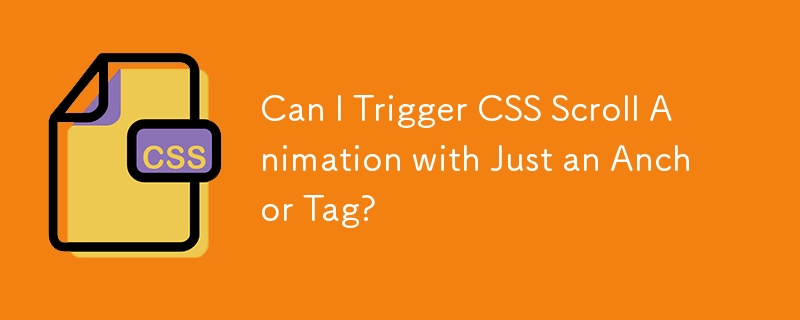Found a total of 10000 related content

HTML, CSS, and jQuery: Build a beautiful page scrolling effect
Article Introduction:HTML, CSS and jQuery: Build a beautiful page scrolling effect In today's era of rapid development of the Internet, web design has become a very important field. In order to attract users, convey information and improve user experience, designers often use various techniques to enhance the visual effect of the page. One of the common techniques is the page scrolling effect, which dynamically scrolls the page to display different content blocks, giving users a new browsing experience. This article will introduce in detail how to use HTML, CSS and jQuery
2023-10-27
comment 0
625

How to use html and CSS to achieve page loading animation effect
Article Introduction:When browsing a website, you will often encounter the page "Loading, please wait" situation. At this time, a circle will appear on the page and keep spinning until the loading is completed. Friends who are learning html and CSS, can you use html and CSS to achieve page loading animation effect? This article will study CSS3 page loading animation with everyone, and share the code of page loading animation with everyone. Interested friends can refer to it.
2018-10-30
comment 0
5382

How to use Layui to develop a full-screen scrolling animation effect
Article Introduction:How to use Layui to develop a full-screen scrolling animation effect Layui is a simple and easy-to-use front-end UI framework. It provides a set of simple CSS and JavaScript components to facilitate developers to quickly build pages. Among them, the full-screen scrolling animation effect is a common effect in many web designs. Below, I will introduce in detail how to use Layui to implement a full-screen scrolling animation effect and provide specific code examples. 1. Preparation Before starting, we need to ensure that the relevant files of Layui have been introduced.
2023-10-27
comment 0
935

How to use HTML, CSS and jQuery to implement scrolling triggering techniques for lazy loading of images
Article Introduction:How to use HTML, CSS and jQuery to implement scrolling triggering techniques for lazy loading of images. In web development, image loading is a common performance problem. If you load too many images at once, page loading speed will be significantly affected, especially on mobile devices. To solve this problem, we can use image lazy loading technology. Lazy loading of images is a method of delaying the loading of images, that is, loading images when the page scrolls to the visible area, rather than loading all images at the beginning. In this way we can reduce
2023-10-27
comment 0
738

How to implement page jump animation effect in uniapp
Article Introduction:How to implement the page jump animation effect in uniapp In uniapp, the page jump animation effect can be achieved by using the built-in navigateTo and redirectTo methods, combined with CSS animation. This article will introduce in detail how to implement page jump animation effect in uniapp, and attach specific code examples. There are two ways to jump pages in uniapp: navigateTo and redirectTo. The difference between them is that the former opens a new page on the current page
2023-12-17
comment 0
1996

HTML+CSS realizes page loading (loading) animation effect
Article Introduction:Have you ever encountered a situation where the page is loading when browsing the page? As a front-end developer, do you know how to use CSS3 and HTML to create a page loading animation effect? This article will share with you a super simple and practical CSS3 circle loading animation effect code. It has certain reference value and interested friends can take a look.
2018-10-16
comment 0
9875

CSS Animation: How to Achieve the Jittering Zoom Effect of Elements
Article Introduction:CSS Animation: How to Achieve the Jitter and Zoom Effect of Elements In web design, the animation effect of elements can increase the user’s visual experience and add vitality to a dull page. CSS animation is one of the powerful tools to achieve these effects. This article will introduce in detail how to use CSS animation to achieve the dithering and scaling effect of elements, and provide specific code examples for readers' reference. The dithering zoom effect is a common animation effect that can play an excellent role in user interaction, page loading and other scenarios. It works by letting elements scale quickly and with random magnitudes
2023-11-21
comment 0
732

CSS property techniques to achieve cool scrolling effects
Article Introduction:CSS property techniques to achieve cool scrolling effects require specific code examples. CSS is an indispensable part of web design. Various effects can be achieved through CSS to improve the interactive experience of web pages. Among them, the scrolling effect is a very common and very cool effect, which can make web page elements scroll to a specified position with a smooth animation effect. This article will introduce some CSS property techniques to achieve cool scrolling effects and provide specific code examples. 1. Use the CSS property scroll-behavior to achieve smooth scrolling
2023-11-18
comment 0
1638

How to achieve scrolling effect in css
Article Introduction:CSS implements scrolling effects. Scroll effects are usually used for various interactions, animations and navigation in website page design. Most conventional website scrolling effects can be achieved through HTML+CSS. This article will briefly introduce several of them. 1. Use the overflow and position attributes to wrap the content (such as div) in the HTML tag. The overflow attribute is scroll, and then use the position attribute to determine the position of the content area to achieve the scrolling effect. The code is as follows: ```<div style="
2023-04-21
comment 0
2273


How to achieve smooth scrolling to the bottom button with CSS
Article Introduction:How to use CSS to implement smooth scrolling to the bottom button In web design, in order to improve the user experience, we often need to add some convenient functions, such as buttons to return to the top of the page or scroll to the bottom. This article will introduce in detail how to use CSS to implement a smooth scroll to the bottom button and provide specific code examples. First, we need to add a button element to the HTML to trigger the scroll to bottom function. You can use tags or <button> tags, depending on your design needs. exist
2023-11-21
comment 0
1117

Advanced techniques on how to use HTML, CSS and jQuery to achieve smooth scrolling effects on pages
Article Introduction:Advanced techniques on how to use HTML, CSS and jQuery to achieve smooth scrolling effects on pages. In modern web design, smooth scrolling effects have become a common requirement. Through the smooth scrolling effect, the page can switch views more smoothly, enhancing the user experience. This article will introduce some advanced techniques on how to use HTML, CSS and jQuery to achieve a smooth scrolling effect on the page, and provide specific code examples. 1. Basic Principles Before we begin, we need to understand the basic principles of achieving smooth scrolling on the page. Basic
2023-10-27
comment 0
855



Detailed introduction to implementing JavaScript animations
Article Introduction:Preface Nowadays, many pages have some kind of animation effect. Appropriate animation effects can improve the beauty of the page to a certain extent, and animations with prompt effects can enhance the usability of the page. There are two ways to implement page animation. One is to indirectly operate CSS styles by operating JavaScript and update them every once in a while; the other is to directly define animations through CSS. The second method was widely adopted after CSS3 matured. In this article, we discuss the principles and implementation of the first approach. JavaScript animation implementation principle First of all, we need to know two important concepts, animation time progression and animation effect progression..
2017-03-14
comment 0
1361

How to achieve ceiling effect in vue
Article Introduction:Preface In web applications, we often need to keep one or more elements in the page in a fixed position when the page is scrolled. This effect is often called a ceiling effect because it makes the element stay in place as if it were glued to the top of the page. There are different ways to achieve ceiling effects in Vue. This article describes one of these methods and provides sample code. Method The method to achieve the ceiling effect in Vue is to listen to page scroll events, calculate the positional relationship between the current scroll position and the ceiling element, and dynamically add or remove CSS styles. Tool
2023-04-18
comment 0
1531

How to achieve the effect of hiding scroll bars in uniapp
Article Introduction:In recent years, with the popularity of mobile applications and websites, users have higher and higher requirements for a good user experience. One important aspect is the performance of the scrolling effect. However, some designers and front-end engineers may feel that the page scrolling effect interferes with the user's visual focus and affects the user experience, thus creating a need to hide the scroll bar. This article will introduce how to achieve the effect of hiding scroll bars in uniapp. 1. Use CSS styles to control scroll bars. CSS hides scroll bars by setting the overflow:hidden style.
2023-04-23
comment 0
6065

Modify scroll bar width jquery
Article Introduction:In web design, scroll bars are an important component that allow users to easily navigate long pages or areas, but due to differences in different browsers and operating systems, the appearance of scroll bars varies. In this case, we may need to modify the style and width of the scroll bar to meet the design requirements, and this can be easily achieved using jQuery. 1. Modify the scroll bar style. First, we need to define a style to override the browser's default scroll bar style. You can refer to the following code: ```css/* external container */.scroll-c
2023-05-28
comment 0
945

CSS page rendering optimization property will-change
Article Introduction:When we trigger the page to draw a large area through certain actions (click, move or scroll), the browser is often unprepared and can only passively use the CPU to calculate and redraw. Without prior preparation, it is difficult to cope with rendering. So the frame drops and freezes. The CSS attribute will-change provides web developers with a way to tell the browser what changes will occur to the element, so that the browser can make corresponding optimization preparations in advance before the element attributes actually change. This kind of optimization can prepare part of the complex calculation work in advance, making the page response faster and more sensitive. This article will introduce the CSS property will-change
2017-02-20
comment 0
1313



















